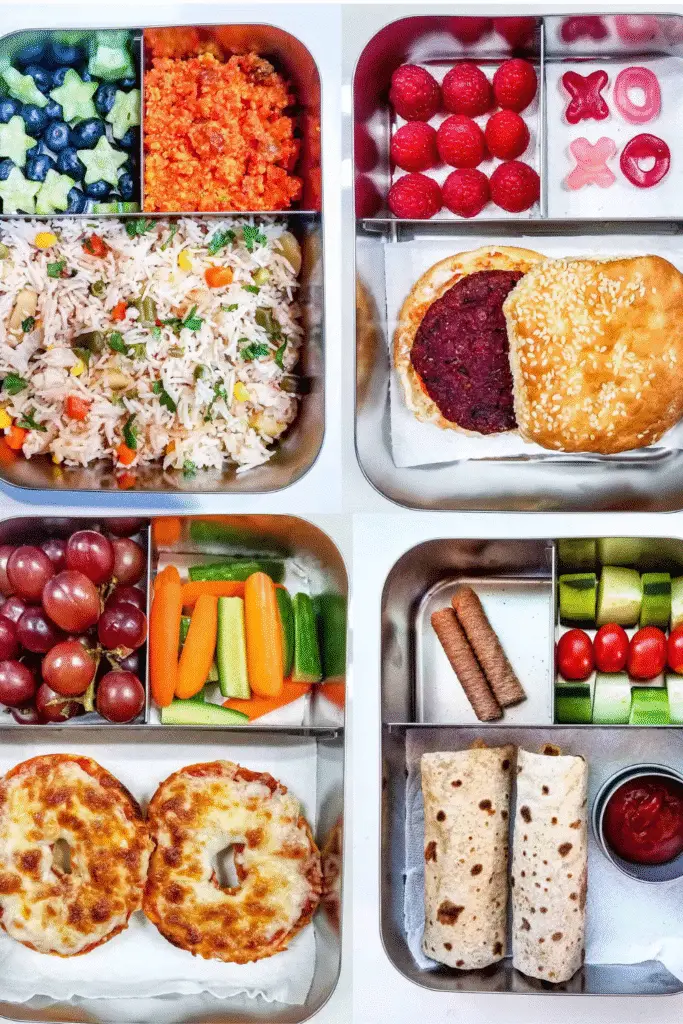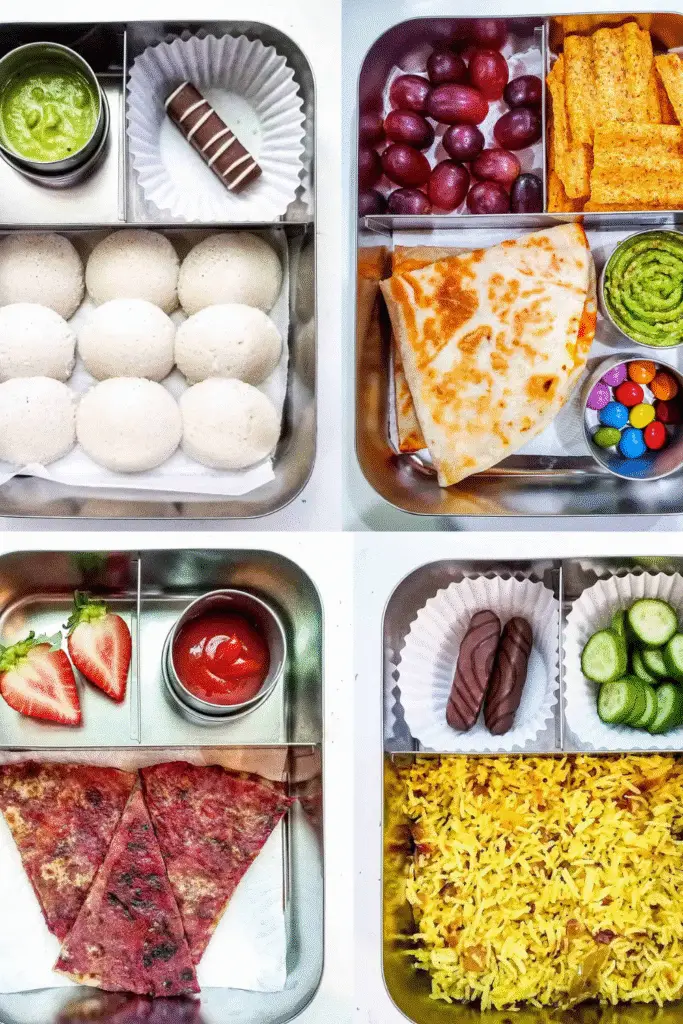Introduction

Did you know that 78% of packed lunches come home partially uneaten, yet children who eat nutritious school lunches show 23% better academic performance throughout the afternoon? This striking paradox highlights a universal parenting challenge: creating school lunch ideas that are both healthy and appealing to young taste buds. The traditional peanut butter and jelly sandwich, while convenient, often fails to provide the sustained energy and nutrition growing minds need.
Modern parents face unique obstacles when planning school lunches: limited prep time, picky eaters, food allergies, and the pressure to create Instagram-worthy lunchboxes. However, with strategic planning and creative approaches, you can transform mundane school meals into exciting, nutritious experiences that fuel your child’s learning and development. These innovative school lunch ideas combine nutritional science with kid-friendly flavors, ensuring your little ones actually consume the healthy foods you lovingly prepare.
Ingredients List
Essential Protein Sources
Main Proteins (Choose 2-3 weekly):
- Natural peanut butter or almond butter (creamy texture appeals to most children)
- Sliced turkey, ham, or chicken breast (low-sodium varieties)
- Hard-boiled eggs (prepare in colorful silicone cups for visual appeal)
- Greek yogurt (vanilla or berry flavors mask the tanginess)
- String cheese and cheese cubes (individually wrapped for convenience)
- Hummus (classic, roasted red pepper, or chocolate varieties)
- Cooked chicken strips or meatballs (homemade or high-quality frozen)
Kid-Friendly Carbohydrates:
- Whole grain bread (soft textures work best for young eaters)
- Tortillas and wraps (colorful spinach or tomato varieties)
- Crackers (whole grain goldfish, pretzels, or rice cakes)
- Fresh fruit (apple slices, grapes, berries, oranges)
- Pasta (fun shapes like bow-ties or shells for cold salads)
Vegetables That Kids Love:
- Cherry tomatoes (sweet and bite-sized)
- Cucumber rounds (mild flavor, satisfying crunch)
- Baby carrots with ranch dip (familiar flavors encourage consumption)
- Bell pepper strips (red and yellow are naturally sweeter)
- Snap peas (fun to eat, naturally sweet)
- Celery sticks (pair with peanut butter or cream cheese)
Flavor Enhancers and Treats:
- Mild mustard, mayo, or cream cheese spreads
- Fresh herbs like basil (introduce gradually)
- Dried fruits (raisins, cranberries, apple chips)
- Nuts and seeds (if school allows – sunflower seeds, almonds)
- Dark chocolate chips or yogurt-covered raisins (portion-controlled treats)
Substitution Guide: Replace peanut products with sunflower seed butter for nut-free schools, use gluten-free bread for celiac requirements, and substitute dairy with plant-based alternatives for lactose-intolerant children.
Timing
Daily Preparation Time: 8-12 minutes per lunch (average across different complexity levels) Weekly Meal Prep Time: 45-60 minutes on Sunday for component preparation Morning Assembly Time: 3-5 minutes with proper prep work Efficiency Comparison: Meal prepping reduces daily lunch-making time by 65% compared to starting from scratch each morning
Time-Saving Strategy: Dedicate Sunday afternoons to washing fruits, pre-cutting vegetables, and preparing proteins. This investment saves 30-40 minutes during busy school mornings while ensuring consistent nutrition quality.
Step-by-Step Instructions
Step 1: Plan Your Weekly Menu with Kid Input
Involve your children in selecting 5-7 different lunch combinations from age-appropriate options. Create a visual menu board with pictures to help younger children understand their choices. This participation increases consumption rates by approximately 40% according to child nutrition studies.
Step 2: Prep Ingredients for Maximum Freshness
Wash and dry all fruits and vegetables immediately after grocery shopping. Cut vegetables into child-friendly sizes and store in clear containers so kids can see their colorful options. Pre-cook proteins like hard-boiled eggs, chicken strips, or meatballs in batches.
Step 3: Create an Assembly Station
Designate a specific area in your kitchen with all lunch components easily accessible. Use clear containers, labels, and child-height storage when possible. This organization streamlines morning routines and allows older children to help pack their own lunches.
Step 4: Master the Balance Formula
Follow the “colorful plate” method: 1/3 protein, 1/3 fruits/vegetables, 1/3 whole grains, plus one small treat. This visual approach ensures nutritional balance while creating appealing, varied lunches that hold children’s interest.
Step 5: Package for Success
Use insulated lunch boxes with ice packs to maintain food safety. Invest in compartmentalized containers that keep foods separate and prevent sogginess. Include small containers for dips and sauces to maintain texture and flavor integrity.
Nutritional Information
Optimal School Lunch Nutritional Profile:
- Calories: 400-600 (depending on child’s age and activity level)
- Protein: 15-20g (supports sustained energy and concentration)
- Carbohydrates: 45-65g (provides quick and sustained brain fuel)
- Healthy Fats: 10-15g (essential for brain development and satiety)
- Fiber: 5-8g (supports digestive health and steady blood sugar)
- Sodium: Less than 600mg (prevents afternoon energy crashes)
Key Nutritional Benefits:
- Balanced macronutrients prevent afternoon hunger and behavior issues
- Complex carbohydrates support sustained cognitive function
- Adequate protein promotes muscle development and concentration
- Natural sugars from fruits provide immediate energy without crashes
- Fiber-rich foods support healthy digestion and prolonged satiety
Age-Specific Considerations:
- Elementary (5-10 years): Focus on familiar flavors with hidden nutrition
- Middle school (11-13 years): Increase portions and include more adventurous options
- High school (14-18 years): Emphasize protein and complex carbs for athletic performance
Healthier Alternatives for the Recipe

Protein Upgrades
Replace processed lunch meats with grilled chicken breast, homemade turkey meatballs, or plant-based proteins like lentil patties. These alternatives provide cleaner nutrition while maintaining familiar flavors that kids enjoy.
Whole Grain Swaps
Substitute white bread with whole grain alternatives, use brown rice instead of white, and choose whole wheat pasta for cold salads. These changes increase fiber content by 200-300% while supporting stable energy levels.
Vegetable Disguises
Incorporate finely chopped vegetables into familiar foods like meatballs, muffins, or pasta salads. Use colorful vegetables as “dips” with hummus or ranch to make them more appealing to reluctant eaters.
Sugar Reduction Strategies
Replace sugary snacks with naturally sweet alternatives like dates stuffed with nut butter, homemade fruit leather, or yogurt parfaits with fresh berries. These swaps reduce added sugar by 70% while maintaining kid-friendly sweetness.
Healthy Fat Additions
Include avocado slices, nuts (when allowed), seeds, or olive oil-based dressings to support brain development and create satisfying meals that prevent afternoon hunger.
Serving Suggestions
Creative Presentation Ideas
Use cookie cutters to create fun shapes from sandwiches, arrange vegetables in rainbow patterns, and include colorful picks or fun napkins. Visual appeal increases consumption rates significantly among school-aged children.
Themed Lunch Days
Create excitement with themed lunches: “Taco Tuesday” with deconstructed tacos, “Mediterranean Monday” with pita, hummus, and vegetables, or “Breakfast for Lunch” with mini pancakes and fruit.
Interactive Elements
Include foods that children can assemble themselves: deconstructed sandwiches, DIY trail mix components, or build-your-own wraps. This engagement increases satisfaction and consumption.
Seasonal Adaptations
Summer: Focus on refreshing fruits, cold soups, and hydrating foods Fall: Include warming spices, seasonal fruits like apples and pears Winter: Add heartier elements like thermos soups and warming foods Spring: Incorporate fresh herbs and lighter, energizing ingredients
Lunchbox Surprises
Include occasional notes, fun facts about their food, or small non-food surprises to maintain excitement about lunchtime and create positive associations with healthy eating.
Common Mistakes to Avoid
Mistake 1: Adult Food Preferences
Avoid imposing adult tastes on children’s lunches. Kids prefer milder flavors, familiar textures, and foods they can eat easily with their hands. Research shows children need 8-12 exposures to new foods before acceptance.
Mistake 2: Inadequate Portions
Sending too little food leads to afternoon hunger and behavior issues, while too much creates waste and guilt. Learn your child’s appetite patterns and adjust portions accordingly.
Mistake 3: Temperature Neglect
Failing to maintain proper food temperatures compromises both safety and taste. Use insulated containers and ice packs consistently, and avoid temperature-sensitive foods in warm weather.
Mistake 4: Overly Complex Meals
Complicated lunches often remain uneaten due to time constraints and social pressures. Keep preparations simple and focus on foods your child can eat within their lunch period.
Mistake 5: Ignoring School Policies
Not researching school allergy policies, heating availability, or eating time constraints can result in confiscated lunches or hungry children. Always check school guidelines before planning.
Storing Tips for the Recipe
Daily Storage Best Practices
Pack lunches in insulated bags with ice packs, especially for dairy and protein items. Store at 40°F or below and consume within 4 hours of leaving refrigeration to maintain food safety standards.
Weekly Prep Storage
- Washed fruits and vegetables: Store in airtight containers with paper towels (3-5 days)
- Cooked proteins: Refrigerate in portioned containers (3-4 days)
- Prepared sandwiches: Wrap individually and freeze (up to 1 month)
- Cut vegetables: Keep in water-filled containers to maintain crispness
Freezer-Friendly Options
Many lunch components freeze well: homemade muffins, pancakes, meatballs, and even some sandwiches. Pre-portion in lunch-sized servings and thaw overnight in the refrigerator.
Container Management
Invest in a variety of container sizes for different foods. Glass containers maintain food quality better than plastic, while leak-proof options prevent messy backpacks and disappointed children.
Food Safety Priorities
Never pack foods that have been sitting at room temperature for more than 2 hours. Use separate containers for wet and dry ingredients, and teach children basic food safety principles.
Conclusion
These comprehensive school lunch ideas transform the daily challenge of meal planning into an opportunity for creativity, nutrition, and family bonding. By combining balanced nutrition with kid-friendly flavors and efficient preparation methods, you’ll create lunches that fuel academic success while building healthy eating habits that last a lifetime.
Start with three new lunch combinations this week and gradually expand your repertoire. Share your successes and challenges in the comments below, and subscribe for weekly meal planning tips, seasonal recipe ideas, and nutrition guidance tailored specifically for growing families.
FAQs
Q: How can I get my picky eater to try new school lunch foods?
A: Start with familiar foods and gradually introduce new elements. Include one new item alongside preferred foods, involve children in lunch planning, and avoid pressure tactics. Research shows it takes 8-12 exposures to new foods before children accept them.
Q: What’s the best way to keep school lunches fresh without refrigeration?
A: Use insulated lunch boxes with ice packs, choose shelf-stable foods when possible, and pack perishables in the center of the lunch box surrounded by other items. Consume within 4 hours of leaving refrigeration for safety.
Q: How do I handle food allergies in school lunch planning?
A: Always check your school’s allergy policies first. Create a “safe foods” list, read all labels carefully, and consider allergy-friendly alternatives like sunflower seed butter instead of peanut butter. Communicate with teachers about emergency procedures.
Q: Are expensive lunch containers worth the investment?
A: Quality containers prevent leaks, maintain food temperature, and last longer than cheaper alternatives. Look for BPA-free materials, easy-to-clean designs, and appropriate portion sizes for your child’s age and appetite.
Q: How can I make school lunches more environmentally friendly?
A: Use reusable containers instead of disposable bags, choose locally-sourced ingredients when possible, include minimal packaging, and teach children about food waste reduction. These practices also often save money long-term.
Q: What should I do if my child consistently brings lunch home uneaten?
A: Evaluate portion sizes, ask about lunch period constraints, consider peer influences, and check if foods are arriving at proper temperatures. Sometimes simple adjustments like cutting sandwiches differently or changing containers can solve the problem.
Transform your child’s school lunch experience with these practical, nutrition-focused ideas that prioritize both health and happiness. Remember that successful school lunches are built on understanding your individual child’s preferences, needs, and school environment.